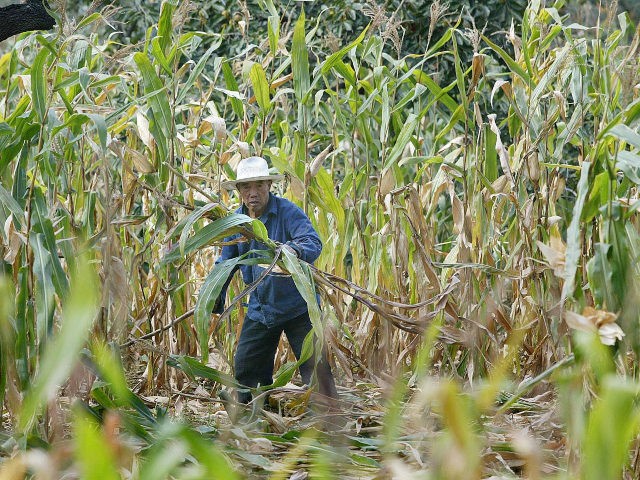America is China’s top supplier of corn so far in 2021, Chinese media noted Sunday, with corn prices in China at record highs.
Corn is used in China for feeding pigs — pork is the nation’s most popular meat — making it an indispensable crop. Increased demand for corn follows not just a devastating African swine flu outbreak that sent pork prices soaring, but torrential floods that destroyed much of China’s 2020 crop yield and raised concerns of food shortages in the world’s most populous nation.
The Chinese Communist Party has repeatedly insisted it is not running out of food for its people, while simultaneously launching a “Clean Plate” campaign that heavily limits food consumption, including banning individuals from eating more than a certain amount of food at weddings and other celebratory occasions. Beijing insists the campaign is in response to a popular social media trend in Asia that features videos of people, often small women, eating abundantly — and not a response to 27 of the country’s 31 states experiencing devastating floods last summer.
The United States took the crown of China’s top corn supplier from Ukraine — which has become increasingly adversarial to China under President Volodymyr Zelensky — in January and February 2021 and is likely to maintain the top position, the Global Times noted.
“This year, the US is set to replace Ukraine as the largest corn supplier to China, and imports of US corn will account for 70 percent of China’s corn imports this year,” an anonymous “expert” told the state-run outlet. America lost its position as China’s top supplier of corn in 2015 under President Barack Obama. The Times credited “increasing demand, soaring prices, and the China-US phase one trade agreement” brokered under President Donald Trump for the change, without mentioning tensions with Kyiv over a Chinese company’s attempted takeover of a top military engine manufacturer there.
The Global Times admitted that “China’s stockpiles have been rapidly depleted,” without elaborating, but predicted that the Communist Party would soon ensure that corn planting domestically would boom to displace some of the imports, keeping China more independent. The Times cited an expert attributing this to “the market” acting on its own, however, without noting the fact that China operates a fully communist economy that does not allow for private businesses of any kind to make decisions independent of the control of the state.
Evidence has mounted in the past month, however, that China may hit a limit on how much of its extensively polluted territory may be available for growing crops. As of 2014, as much as a fifth of Chinese farmland was rendered unusable by chemical contamination, Reuters noted in 2019.
In remarks in March, Bryan Lohmar, China Director for the U.S. Grains Council, reportedly made the case that American farmers will be able to expect to sell corn to China in the long term in part because of the poor quality of China’s soil.
“Lohmar also said Chinese officials in recent years have become more concerned about soil health and soil exhaustion,” Kansas’s High Plains Journal reported. “While parts of China benefit from the loess plateau, with some of the world’s most fertile soils, overall China only has 7 percent of the world’s arable land to feed its population, a fifth of the global total.”
“Continuous corn plantings can exhaust soils and reduce future yields,” the newspaper noted. “Lohmar said that while China is likely to introduce GMO corn within the next few years, even that may not substantially increase yields as long as soils in some areas are depleted by corn monocropping and need to be restored.”
“China has been scooping up record amounts of corn and soybeans from overseas to feed the world’s largest hog herd, which is recovering from African swine fever,” the outlet reported. “The country faces shortages of farm commodities because of a lack of productive farmland and increasing demand from a more affluent population, and is trying to boost yields and reduce wastage.”
Corn reportedly joined record imports of wheat, beef, pork, sorghum, and sugar.
China faced an especially challenging agricultural year in 2020. A combination of devastating floods and a locust infestation caused at least $1.45 billion in economic losses by some estimates. The floods affected 27 provinces, 55 million people, and destroyed 5.28 hectares of farmland. The flooding threatened the structurally compromised Three Gorges Dam, leading to Communist Party officials blowing up smaller dams and deliberately flooding entire communities to preserve the iconic dam. Many farmers reported entire fields underwater; others had no way of shipping the crops they had grown to vendors through the floods, resulting in rot.
In August, dictator Xi Jinping announced the launch of the “Clean Plate” campaign, accusing Chinese citizens of “shocking and distressing” food waste that the Communist Party would soon end. The campaign banned the controversial videos of people eating large feasts on their own and required catering companies to use technology to regulate exactly how much food people eat at private events, banning them from selling more food than the government’s preferred amount for any group of people to eat. The legislation that resulted from the campaign also required restaurants to cover their establishments in government propaganda browbeating patrons not to order too much food.
“Despite media hype that China is in a looming food crisis, which is worsened by the epidemic, floods in southern China, and food imports, Chinese agriculturalists said the above factors will not lead to a food crisis in China,” the state-run Global Times propaganda outlet insisted following Xi’s launch of the “Clean Plate” campaign.
China appeared to again change its tune in February, as corn imports from the United States rose. Minister of Agriculture Tang Renjian gingerly told reporters in a press briefing that month that China’s food supply “at times comes under pressure.”

COMMENTS
Please let us know if you're having issues with commenting.